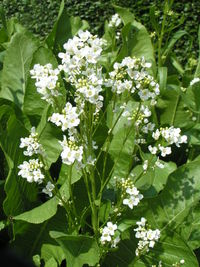
Targeted silencing of genes in polyploids: lessons learned from Brassica juncea-glucosinolate system
Sign Up to like & getrecommendations! Published in 2018 at "Plant Cell Reports"
DOI: 10.1007/s00299-018-2348-8
Abstract: Key messageIntron-spliced hairpin RNAi construct targeting the exonic region of BjuMYB28 driven by the native promoter is the best suited strategy for developing viable low glucosinolate lines in polyploid Brassica juncea.AbstractTargeted silencing of specific homolog(s)… read more here.
Keywords: juncea; system; glucosinolate; brassica juncea ... See more keywords

Glucosinolate variation among organs, growth stages and seasons suggests its dominant accumulation in sexual over asexual-reproductive organs in white radish
Sign Up to like & getrecommendations! Published in 2022 at "Scientia Horticulturae"
DOI: 10.1016/j.scienta.2021.110617
Abstract: Abstract Radish (Raphanus sativus L.), a root vegetable crop, contains a large amount of glucosinolate but information on its changes in field condition among different organs, growth stages and seasons is very limited. The glucosinolate… read more here.
Keywords: stages seasons; glucosinolate; organs growth; spring ... See more keywords

A naturally occurring variation in the BrMAM-3 gene is associated with aliphatic glucosinolate accumulation in Brassica rapa leaves
Sign Up to like & getrecommendations! Published in 2018 at "Horticulture Research"
DOI: 10.1038/s41438-018-0074-6
Abstract: Glucosinolate profiles significantly vary among Brassica rapa genotypes. However, the molecular basis of these variations is largely unknown. In this study, we investigated a major quantitative trait locus (QTL) controlling aliphatic glucosinolate accumulation in B.… read more here.
Keywords: brmam; accumulation; glucosinolate; rapa leaves ... See more keywords

The genome sequence of Barbarea vulgaris facilitates the study of ecological biochemistry
Sign Up to like & getrecommendations! Published in 2017 at "Scientific Reports"
DOI: 10.1038/srep40728
Abstract: The genus Barbarea has emerged as a model for evolution and ecology of plant defense compounds, due to its unusual glucosinolate profile and production of saponins, unique to the Brassicaceae. One species, B. vulgaris, includes… read more here.
Keywords: biochemistry; genome sequence; ecological biochemistry; barbarea ... See more keywords

Identification and Characterization of Genes Involved in Field Pennycress (Thlaspi arvense L.) Glucosinolate Production (nzz047.OR20-06-19).
Sign Up to like & getrecommendations! Published in 2019 at "Current developments in nutrition"
DOI: 10.1093/cdn/nzz047.or20-06-19
Abstract: Objectives Field pennycress (Thlaspi arvense L.) is a winter annual oilseed undergoing development as a cash cover crop for the Upper Midwest. While it provides ecosystem benefits when planted between conventional crop rotations, there are… read more here.
Keywords: glucosinolate production; expression; glucosinolate; pennycress ... See more keywords

Enhancing canola breeding by editing a glucosinolate transporter gene lacking natural variation
Sign Up to like & getrecommendations! Published in 2022 at "Plant Physiology"
DOI: 10.1093/plphys/kiac021
Abstract: A low seed glucosinolate resource was developed in polyploid B. napus using a method that identifies the functions of genes with rare or no genetic variation. read more here.
Keywords: editing glucosinolate; glucosinolate; variation; enhancing canola ... See more keywords

Ablation of glucosinolate accumulation in the oil crop Camelina sativa by targeted mutagenesis of genes encoding the transporters GTR1 and GTR2 and regulators of biosynthesis MYB28 and MYB29
Sign Up to like & getrecommendations! Published in 2022 at "Plant Biotechnology Journal"
DOI: 10.1111/pbi.13936
Abstract: Summary Camelina sativa is an oil crop with low input costs and resistance to abiotic and biotic stresses. The presence of glucosinolates, plant metabolites with adverse health effects, restricts the use of camelina for human… read more here.
Keywords: crop; glucosinolate; oil; camelina sativa ... See more keywords

Glucosinolate Biosynthesis and the Glucosinolate–Myrosinase System in Plant Defense
Sign Up to like & getrecommendations! Published in 2020 at "Agronomy"
DOI: 10.3390/agronomy10111786
Abstract: Insect pests represent a major global challenge to important agricultural crops. Insecticides are often applied to combat such pests, but their use has caused additional challenges such as environmental contamination and human health issues. Over… read more here.
Keywords: glucosinolate; glucosinolate biosynthesis; plant defense; defense ... See more keywords

Genome-Wide Association Study of Glucosinolate Metabolites (mGWAS) in Brassica napus L.
Sign Up to like & getrecommendations! Published in 2023 at "Plants"
DOI: 10.3390/plants12030639
Abstract: Glucosinolates (GSLs) are secondary plant metabolites that are enriched in rapeseed and related Brassica species, and they play important roles in defense due to their anti-nutritive and toxic properties. Here, we conducted a genome-wide association… read more here.
Keywords: glucosinolate; genome wide; association study; wide association ... See more keywords